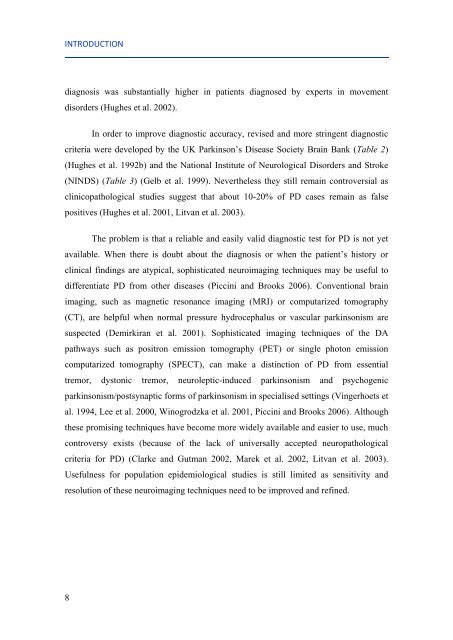Mechanisms of aluminium neurotoxicity in oxidative stress-induced ...
Mechanisms of aluminium neurotoxicity in oxidative stress-induced ...
Mechanisms of aluminium neurotoxicity in oxidative stress-induced ...
You also want an ePaper? Increase the reach of your titles
YUMPU automatically turns print PDFs into web optimized ePapers that Google loves.
INTRODUCTION<br />
diagnosis was substantially higher <strong>in</strong> patients diagnosed by experts <strong>in</strong> movement<br />
disorders (Hughes et al. 2002).<br />
8<br />
In order to improve diagnostic accuracy, revised and more str<strong>in</strong>gent diagnostic<br />
criteria were developed by the UK Park<strong>in</strong>son‟s Disease Society Bra<strong>in</strong> Bank (Table 2)<br />
(Hughes et al. 1992b) and the National Institute <strong>of</strong> Neurological Disorders and Stroke<br />
(NINDS) (Table 3) (Gelb et al. 1999). Nevertheless they still rema<strong>in</strong> controversial as<br />
cl<strong>in</strong>icopathological studies suggest that about 10-20% <strong>of</strong> PD cases rema<strong>in</strong> as false<br />
positives (Hughes et al. 2001, Litvan et al. 2003).<br />
The problem is that a reliable and easily valid diagnostic test for PD is not yet<br />
available. When there is doubt about the diagnosis or when the patient‟s history or<br />
cl<strong>in</strong>ical f<strong>in</strong>d<strong>in</strong>gs are atypical, sophisticated neuroimag<strong>in</strong>g techniques may be useful to<br />
differentiate PD from other diseases (Picc<strong>in</strong>i and Brooks 2006). Conventional bra<strong>in</strong><br />
imag<strong>in</strong>g, such as magnetic resonance imag<strong>in</strong>g (MRI) or computarized tomography<br />
(CT), are helpful when normal pressure hydrocephalus or vascular park<strong>in</strong>sonism are<br />
suspected (Demirkiran et al. 2001). Sophisticated imag<strong>in</strong>g techniques <strong>of</strong> the DA<br />
pathways such as positron emission tomography (PET) or s<strong>in</strong>gle photon emission<br />
computarized tomography (SPECT), can make a dist<strong>in</strong>ction <strong>of</strong> PD from essential<br />
tremor, dystonic tremor, neuroleptic-<strong>in</strong>duced park<strong>in</strong>sonism and psychogenic<br />
park<strong>in</strong>sonism/postsynaptic forms <strong>of</strong> park<strong>in</strong>sonism <strong>in</strong> specialised sett<strong>in</strong>gs (V<strong>in</strong>gerhoets et<br />
al. 1994, Lee et al. 2000, W<strong>in</strong>ogrodzka et al. 2001, Picc<strong>in</strong>i and Brooks 2006). Although<br />
these promis<strong>in</strong>g techniques have become more widely available and easier to use, much<br />
controversy exists (because <strong>of</strong> the lack <strong>of</strong> universally accepted neuropathological<br />
criteria for PD) (Clarke and Gutman 2002, Marek et al. 2002, Litvan et al. 2003).<br />
Usefulness for population epidemiological studies is still limited as sensitivity and<br />
resolution <strong>of</strong> these neuroimag<strong>in</strong>g techniques need to be improved and ref<strong>in</strong>ed.

















